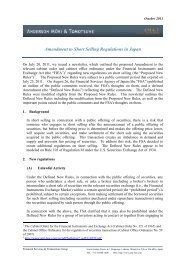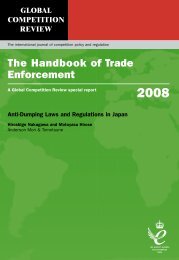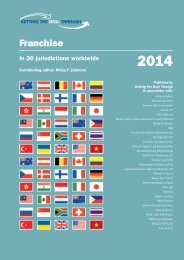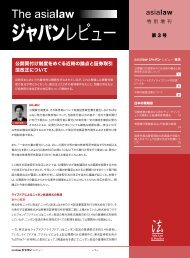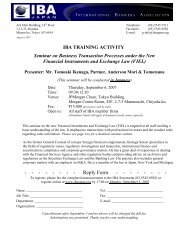Corporate Recovery and Insolvency 2013
Corporate Recovery and Insolvency 2013
Corporate Recovery and Insolvency 2013
You also want an ePaper? Increase the reach of your titles
YUMPU automatically turns print PDFs into web optimized ePapers that Google loves.
The International Comparative Legal Guide to:<strong>Corporate</strong> <strong>Recovery</strong> <strong>and</strong> <strong>Insolvency</strong> <strong>2013</strong>7th EditionA practical cross-border insight into corporate recovery <strong>and</strong> insolvency workPublished by Global Legal Group, in association with CDR, with contributions from:Ali Budiardjo, Nugroho, ReksodiputroAllen & Overy LLPALMT Legal, Advocates & SolicitorsAnderson Mōri & TomotsuneAndreas M. Sofocleous & Co. LLCAttorneys at law Borenius LtdBaker & PartnersBonelli Erede PappalardoCampbellsClifford Chance LLCCosta, Waisberg e Tavares Paes Sociedade de AdvogadosEl-Borai & PartnersGallGilbert + TobinGorrissen FederspielHengeler MuellerHogan Lovells Studio LegaleKing & Wood MallesonsLenz & StaehelinLoyens & LoeffOlswang LLPOsler, Hoskin & Harcourt LLPPaul, Weiss, Rifkind, Wharton & Garrison LLPPekin & PekinRESOR N.V.Rivera Gaxiola, Carrasco y BarreraSchoenherrSedgwick ChudleighSlaughter <strong>and</strong> MayUría MenéndezWhite & Case LLPZaka & Kosta Attorneys at Law
The International Comparative Legal Guide to: <strong>Corporate</strong> <strong>Recovery</strong> <strong>and</strong> <strong>Insolvency</strong> <strong>2013</strong>Contributing EditorSarah Paterson, Slaughter<strong>and</strong> MayAccount ManagersBeth Bassett, RobertHopgood, Dror Levy,Maria Lopez, FlorjanOsmani, Oliver Smith,Rory SmithSales Support ManagerToni WyattSub EditorsBeatriz ArroyoFiona CanningEditorSuzie KiddSenior EditorPenny SmaleGroup Consulting EditorAlan FalachGroup PublisherRichard FirthPublished byGlobal Legal Group Ltd.59 Tanner StreetLondon SE1 3PL, UKTel: +44 20 7367 0720Fax: +44 20 7407 5255Email: info@glgroup.co.ukURL: www.glgroup.co.ukGLG Cover DesignF&F Studio DesignGLG Cover Image SourceiStockphotoPrinted byAshford Colour Press LtdJune <strong>2013</strong>Copyright © <strong>2013</strong>Global Legal Group Ltd.All rights reservedNo photocopyingISBN 978-1-908070-66-1ISSN 1754-0097Strategic PartnersGeneral Chapters:1 Stabilus Group: A Case Study of Issues that Arise in Complex Financial Restructurings –Sarah Paterson & Megan Sparber, Slaughter <strong>and</strong> May 12 Schemes of Arrangement under the Companies Act 2006 for Foreign Companies – AliciaVideon & Julian Turner, Olswang LLP 63 The Impact of the 2012 <strong>Insolvency</strong> Law Reform of Arrangements with Creditors Procedures:New Scenarios on the Italian Front – Filippo Chiaves, Hogan Lovells Studio Legale 13Country Question <strong>and</strong> Answer Chapters:4 Albania Zaka & Kosta Attorneys at Law: Entela Memishaj Shehaj & Enis Boriçi 175 Australia Gilbert + Tobin: Dominic Emmett & Nicholas Edwards 236 Austria Schoenherr: Wolfgang Höller & Georg Wielinger 307 Belgium Allen & Overy LLP: Koen Van den Broeck & Thales Mertens 368 Bermuda Sedgwick Chudleigh: Alex Potts & Mark Chudleigh 429 Brazil Costa, Waisberg e Tavares Paes Sociedade de Advogados: Ivo Waisberg 5110 Bulgaria Schoenherr (in cooperation with Advokatsko Druzhestvo Andreev,Stoyanov & Tsekova): Anton Andreev 5711 Canada Osler, Hoskin & Harcourt LLP: Tracy C. S<strong>and</strong>ler & Andrea M. Lockhart 6312 Cayman Isl<strong>and</strong>s Campbells: J. Ross McDonough & Guy Cowan 7013 China King & Wood Mallesons: Zheng Zhibin & Zhang Ting 7614 Cyprus Andreas M. Sofocleous & Co. LLC: Antria Christoforou & Nina Ebanoidze 8015 Denmark Gorrissen Federspiel: John Sommer Schmidt 8616 Egypt El-Borai & Partners: Dr. Ahmed El Borai & Dr. Ramy El Borai 9117 Engl<strong>and</strong> & Wales Slaughter <strong>and</strong> May: Sarah Paterson & Thomas Vickers 9718 Finl<strong>and</strong> Attorneys at law Borenius Ltd: Mika Salonen & Aleksi Muhonen 10819 France Allen & Overy LLP: Rod Cork & Marc Santoni 11420 Germany Hengeler Mueller: Dr. Ulrich Blech 12321 Hong Kong Gall: R<strong>and</strong>all Arthur & Anjelica Tang 13022 India ALMT Legal, Advocates & Solicitors: Gautam Bhatikar & Kruti Desai 13623 Indonesia Ali Budiardjo, Nugroho, Reksodiputro: Theodoor Bakker &Herry N. Kurniawan 14224 Italy Bonelli Erede Pappalardo: Vittorio Lupoli & Andrea De Tomas 14725 Japan Anderson Mōri & Tomotsune: Tomoaki Ikenaga & Nobuyuki Maeyama 15726 Jersey Baker & Partners: David Wilson & Ed Shorrock 16327 Luxembourg Loyens & Loeff: Véronique Hoffeld & Laurent Lenert 16828 Mexico Rivera Gaxiola, Carrasco y Barrera: Alonso Rivera Gaxiola &Abraham Gómez Velázquez 17529 Montenegro Moravčević Vojnović i Partneri in cooperation with Schoenherr: SlavenMoravčević & Nikola Babić 18330 Netherl<strong>and</strong>s RESOR N.V.: Lucas Kortmann & Karin Sixma 18931 Portugal Uría Menéndez − Proença de Carvalho: Pedro Ferreira Malaquias &David Sequeira Dinis 19632 Serbia Moravčević Vojnović i Partneri in cooperation with Schoenherr: MatijaVojnović & Vojimir Kurtić <strong>2013</strong>3 Slovenia Schoenherr: Ana Filipov & Vid Kobe 20834 Spain Uría Menéndez: Alberto Núñez-Lagos Burguera & Ángel Alonso Hernández 21535 Sweden White & Case LLP: Carl Hugo Parment & Michael Gentili 22236 Switzerl<strong>and</strong> Lenz & Staehelin: Daniel Tunik & Tanja Luginbühl 22837 Turkey Pekin & Pekin: Gökben Erdem Dirican & Erdem Atilla 23638 Ukraine Clifford Chance LLC: Olexiy Soshenko & Andrii Grebonkin 24539 USA Paul, Weiss, Rifkind, Wharton & Garrison LLP: Alan W. Kornberg &Elizabeth R. McColm 252Further copies of this book <strong>and</strong> others in the series can be ordered from the publisher. Please call +44 20 7367 0720DisclaimerThis publication is for general information purposes only. It does not purport to provide comprehensive full legal or other advice.Global Legal Group Ltd. <strong>and</strong> the contributors accept no responsibility for losses that may arise from reliance upon information contained in this publication.This publication is intended to give an indication of legal issues upon which you may need advice. Full legal advice should be taken from a qualifiedprofessional when dealing with specific situations.www.ICLG.co.uk
Chapter 25JapanTomoaki IkenagaAnderson Mōri & TomotsuneNobuyuki Maeyama1 Issues Arising When a Company is inFinancial Difficulties1.1 How does a creditor take security over assets in Japan?Mortgages (Teito-ken) <strong>and</strong> Revolving Mortgages (Ne-teito-ken)on Real EstateMortgages <strong>and</strong> revolving mortgages on real estate may be grantedas security for a debt. Ownership of the underlying asset is nottransferred, but rather its transfer is restricted by the possibleenforcement of the mortgage through judicial foreclosure.Pledges (shichi-ken) on Real Estate, Moveables (includingSecurities) <strong>and</strong> Monetary ObligationsA pledge is a security interest on ownership of the underlying assetor title for a debt. A pledge on real estate or moveables is createdby an agreement between the owner of real estate or moveables(pledgor) <strong>and</strong> the pledge-holder (pledgee). A pledge on a monetaryobligation is created by agreement between an obligee (pledgor)<strong>and</strong> the pledge-holder (pledgee).Note that, as listed securities are subject to electronic registrationwith the Japan Securities Depository Center, Inc. (JASDEC),pledges should be created <strong>and</strong> perfected on the listed securities byregistration of the pledge with JASDEC.Transfer Pledges (Joto Tampo) on Real Estate, Moveables(including Securities) <strong>and</strong> Monetary ObligationsA transfer pledge is a security interest created by agreementbetween the transfer-pledgee <strong>and</strong> either the owner of the realestate/moveables or the obligee of the monetary obligation(pledgor).1.2 In what circumstances might transactions entered intowhilst the company is in financial difficulties be vulnerableto attack?As explained in section 2, there are Civil RehabilitationProceedings, <strong>Corporate</strong> Reorganisation Proceedings <strong>and</strong>Bankruptcy Proceedings. The following explains avoidance by atrustee in Bankruptcy Proceedings, a supervisor in CivilRehabilitation Proceedings <strong>and</strong> an administrator of <strong>Corporate</strong>Reorganisation Proceedings. Note there are other avoidanceactions available as well.A. Avoidance of Fraudulent TransfersAny transaction by the company (excluding a transaction forproviding collateral by the company or discharging an obligation ofthe company) can be avoided if:(i)the company knows that the transaction is detrimental tocreditors; however, the transaction will not be avoided if aperson who is subject to an avoidance action <strong>and</strong> receives abenefit from the transaction (the “Beneficiary”) proves thathe had no knowledge of such fact at the time of thetransaction; or(ii) the transaction is detrimental to creditors <strong>and</strong> executed after thecompany suspends payment or a petition for CivilRehabilitation Proceedings, <strong>Corporate</strong> ReorganisationProceedings or Bankruptcy Proceedings is filed; however, thetransaction will not be avoided if the Beneficiary proves that hehad no knowledge of such facts at the time of the transaction.B. Avoidance of PreferencesAny transaction by the company which provides collateral to acreditor for an existing obligation of the company or discharges anexisting obligation of the company is avoidable if:(i) the transaction is executed after: (a) the company becomesunable to pay its debts when due; or (b) a petition for CivilRehabilitation Proceedings, <strong>Corporate</strong> ReorganisationProceedings or Bankruptcy Proceedings is filed; <strong>and</strong>(ii) the creditor knows that: (a) the company becomes unable topay its debts when due or suspends payments in case of(i)(a); or (b) a petition for Civil Rehabilitation Proceedings,<strong>Corporate</strong> Reorganisation Proceedings or BankruptcyProceedings is filed in case of (i)(b).In addition, if the above transaction occurs within 30 days beforethe company becomes unable to pay, <strong>and</strong> (i) the company is notobligated to perform the transaction, or (ii) the transactionconstitutes the performance of an obligation by the company that isnot then due, the transaction can be avoided. However, thetransaction cannot be avoided if the creditor proves that he does notknow that the transaction is detrimental to other creditors.C. Avoidance of a Transaction in Exchange of ReasonablyEquivalent ValueDisposition of an asset by the company in exchange for areasonably equivalent value can be avoided only if all of the belowrequirements are met:(i) the disposition results in changing the form of the asset, suchas, by way of example, disposition of real estate for cash, <strong>and</strong>creates a present danger that the company will take furtheraction which would be detrimental to creditors (“MaliciousAction”), such as, by way of example, hiding the asset,providing the asset for no consideration to specific creditors,or taking other action;(ii) the company has an intent to take Malicious Action at thetime of the disposition; <strong>and</strong>(iii) the counterparty to the disposition knows that the companyhas the intent above at the time of the disposition.ICLG TO: CORPORATE RECOVERY AND INSOLVENCY <strong>2013</strong>© Published <strong>and</strong> reproduced with kind permission by Global Legal Group Ltd, LondonWWW.ICLG.CO.UK157
Anderson Mōri & TomotsuneJapanJapanD. Avoidance of PerfectionPerfection can be avoided if the act of perfection:(i) occurs after the company suspends payments or a petition forCivil Rehabilitation Proceedings, <strong>Corporate</strong> ReorganisationProceedings or Bankruptcy Proceedings is filed;(ii) is taken after 15 days from creation, transfer or change ofcreditors’ rights; <strong>and</strong>(iii) is taken with knowledge of the company’s suspension ofpayments to creditors or the filing of a petition for CivilRehabilitation Proceedings, <strong>Corporate</strong> ReorganisationProceedings or Bankruptcy Proceedings.1.3 What are the liabilities of directors (in particular civil,criminal or disqualification) for continuing to trade whilst acompany is in financial difficulties in Japan?C. Bankruptcy ProceedingsBankruptcy Proceedings are liquidation proceedings administeredby a court-appointed trustee. Secured creditors are not subject tothe proceeding <strong>and</strong> are free to enforce their collateral. Thecompany is liquidated <strong>and</strong> there may be a distribution at the end ofthe proceeding to creditors.2.2 What are the tests for insolvency in Japan?The test is whether the total liabilities of the company exceed thetotal assets of the company. If so, then the company is regarded as“insolvent” under the Company Act. However, as described below,the grounds for commencing insolvency proceedings are notnecessarily triggered by insolvency alone.There are no specific statutes imposing civil or criminal liability ondirectors under the circumstances described above. However, if adirector of the company knows, or reasonably should know, thatpayment for an obligation will not be made at the time of thetransaction, then such director may be liable for damages incurredby the counterparty to the transaction.2 Formal Procedures2.1 What are the main types of formal procedures availablefor companies in financial difficulties in Japan?A. Civil Rehabilitation ProceedingsCivil Rehabilitation Proceedings are debtor-in-possession (“DIP”)proceedings, where the incumbent management remains in place<strong>and</strong> proposes a rehabilitation plan to creditors. DIP proceedings aresubject to the supervision of a supervisor appointed by the court.The DIP’s rehabilitation plan must be approved by the creditors.Secured creditors are excluded from the proceedings <strong>and</strong> are free toenforce their collateral.B. <strong>Corporate</strong> Reorganisation Proceedings<strong>Corporate</strong> Reorganisation Proceedings are the most powerfulinsolvency proceedings, whereby all secured creditors <strong>and</strong>unsecured creditors are subject to the proceeding. After the petitionfor commencement, the court issues: (i) an Administration Order,which divests the authority of the incumbent management <strong>and</strong>appoints an Interim Administrator; <strong>and</strong> (ii) a Protection Order,which prohibits the company from paying any debt (with certainexceptions). The court may also issue a Comprehensive ProtectionOrder prohibiting any secured creditor from enforcing its rights incollateral. After the Interim Administrator’s review <strong>and</strong>investigation, the court may appoint an administrator who has fullresponsibility to manage the company <strong>and</strong> create a reorganisationplan, which is subject to approval of the creditors <strong>and</strong> the court.Recently, the Tokyo District Court started DIP-type <strong>Corporate</strong>Reorganisation Proceedings, where the court does not issue anAdministration Order <strong>and</strong> the incumbent management remains inpower. In such proceedings, the court issues (i) a Protection Orderprohibiting the company from paying any debt (with certainexceptions), <strong>and</strong> (ii) a Supervision <strong>and</strong> Investigation Order,pursuant to which the court appoints a Supervisor/Investigator tocarry out an initial review of whether the DIP proceeding isappropriate for the case. After the Supervisor/Investigator’s review,in typical cases one of the company’s directors is appointed asadministrator to carry out the business of the company.2.3 On what grounds can the company be placed into eachprocedure?A. Bankruptcy ProceedingsIf a company is generally <strong>and</strong> continuously unable to pay its debtswhen due, Bankruptcy Proceedings may be commenced. As amatter of law, a company is presumed to be generally <strong>and</strong>continuously unable to pay its debts if (i) the company fails to paya promissory note or important debt such as the principal of acorporate bond or bank loans, or other obligations in general, or (ii)the company is “insolvent”.B. Civil Rehabilitation Proceedings <strong>and</strong> <strong>Corporate</strong>Reorganisation ProceedingsA company may file a petition to commence the proceedings if (i)there is a possibility that the grounds for commencing BankruptcyProceedings may occur, or (ii) the company is unable to pay itsobligations without creating a significant burden for continuing itsbusiness.2.4 Please describe briefly how the company is placed intoeach procedure.Voluntary PetitionA voluntary petition is generally commenced by evaluating thefinancial status of the company <strong>and</strong> the selection of the appropriateproceedings with the assistance of attorneys <strong>and</strong> accountants. Theboard then adopts a resolution to file a petition for one of theproceedings.Involuntary PetitionThe proceedings may also be commenced by an involuntarypetition, although such practice is uncommon. Under <strong>Corporate</strong>Reorganisation Proceedings, only creditors who have claims inexcess of a minimum threshold are entitled to file involuntarypetitions. Requirements for commencing involuntary cases includethe petitioner’s proof that the company has grounds for thecommencement of the proceedings, which are the same as those forcommencing voluntary Bankruptcy Proceedings.2.5 What notifications, meetings <strong>and</strong> publications are requiredafter the company has been placed into each procedure?With respect to Civil Rehabilitation Proceedings, <strong>Corporate</strong>Reorganisation Proceedings or Bankruptcy Proceedings, no actualnotice to creditors is required with respect to commencement of thecase, the filing deadline for a proof of claim (bar date), etc. Instead,the law provides that any notice shall be publicly posted in158WWW.ICLG.CO.UK© Published <strong>and</strong> reproduced with kind permission by Global Legal Group Ltd, LondonICLG TO: CORPORATE RECOVERY AND INSOLVENCY <strong>2013</strong>
Anderson Mōri & TomotsuneJapanGovernment Official Gazettes. There are some exceptions wherethe actual notice by the court is necessary.3.2 Can secured creditors enforce their security in eachprocedure?2.6 Are “pre-packaged” sales possible?Pre-packaged sales are possible both in Civil RehabilitationProceedings <strong>and</strong> <strong>Corporate</strong> Reorganisation Proceedings. Beforefiling a petition for the commencement of these proceedings, thedebtor must locate a buyer <strong>and</strong> obtain the consent of the largestcreditors with respect to any such sale. After the petition is filed,such sale is carried out following court approval <strong>and</strong> may involve acompetitive bidding process among other potential buyers.3 Creditors3.1 Are unsecured creditors free to enforce their rights ineach procedure?A. Civil Rehabilitation Proceedings <strong>and</strong> BankruptcyProceedingsSecured creditors can generally enforce their security outside of theproceedings. However, under certain conditions, the security willbe cancelled by the court or its enforcement by the creditor will bestayed.B. <strong>Corporate</strong> Reorganisation ProceedingsSecured creditors can only enforce their securities within theproceeding as a “Creditor with Security in <strong>Corporate</strong>Reorganisation Proceedings”. Thus, claims of secured creditorswill be paid pursuant to the reorganisation plan. However, claimsof secured creditors are entitled to priority in <strong>Corporate</strong>Reorganisation Proceedings. Further, under certain conditions, asecured creditor can enforce its security outside the proceeding withthe approval of the court.JapanUnsecured creditors are prohibited from enforcing their unsecuredclaims outside of each proceeding. However, the followingexceptions are applicable to unsecured claims.A. Civil Rehabilitation ProceedingsWith respect to unsecured claims, “Common Benefit Claims” <strong>and</strong>“General Priority Claims” can be enforced outside the proceeding.“Common Benefit Claims”, as a rule, include:(i) a claim for expenses necessary for execution of theproceeding (e.g., remuneration of a supervisor); <strong>and</strong>(ii) a claim arising from the business operations of the companyafter the commencement of the proceeding.“General Priority Claims” include:(i) a claim for wages or salary of an employee; <strong>and</strong>(ii) a tax claim.B. <strong>Corporate</strong> Reorganisation ProceedingsWith respect to unsecured claims, only “Common Benefit Claims”can be enforced outside the proceeding, in principle. “CommonBenefit Claims” in <strong>Corporate</strong> Reorganisation Proceedings, as a rule,include the following:(i) a claim for expenses necessary for execution of theproceeding (e.g., remuneration of an administrator of theproceeding);(ii) a claim arising from the business operations of the companyafter the commencement of the proceeding; <strong>and</strong>(iii) a claim for an employee’s wages or salary for a certainperiod.Courts have been recently allowing the administrator to pay acertain amount of claims arising from commercial transactionsoutside the proceeding (e.g., trade creditors). The purpose of thispractice is to make it easier to continue the company’s businessoperations by discouraging essential suppliers from ceasing to dobusiness with the company.C. Bankruptcy ProceedingsWith respect to unsecured claims, “Estate Claims” can be enforcedoutside a bankruptcy procedure. “Estate Claims” in bankruptcyproceeding, as a rule, include:(i) a claim for expenses necessary for execution of theproceeding (e.g., remuneration for a trustee of theprocedure); <strong>and</strong>(ii) a claim for the wages or salary of an employee for a certainperiod.3.3 Can creditors set off sums owed by them to the companyagainst amounts owed by the company to them in eachprocedure?A. General RuleGenerally speaking, creditors can exercise the right of set off.B. ExceptionsIn a typical set off, it is necessary for the obligations of each partyto be due <strong>and</strong> owing. However, upon the commencement of aBankruptcy Proceeding, the obligations of the debtor becomeimmediately due. In Civil Rehabilitation <strong>and</strong> <strong>Corporate</strong>Reorganisation, creditors cannot set off obligations owed by thedebtor until the due date of such obligations. Further, in CivilRehabilitation Proceedings <strong>and</strong> <strong>Corporate</strong> ReorganisationProceedings, creditors can only exercise the right of set off withinthe period for the filing of their claims specified by the court.4 Continuing the Business4.1 Who controls the company in each procedure? Inparticular, please describe briefly the effect of theprocedures on directors <strong>and</strong> shareholders.A. Civil Rehabilitation ProceedingsIn Civil Rehabilitation Proceedings, directors of the companymaintain authority to control the company <strong>and</strong> administer <strong>and</strong>dispose of its assets. However, where the company will conductmaterial actions including disposition of assets, the approval of thesupervisor appointed by the court is necessary.When a Civil Rehabilitation Proceeding is commenced, directors<strong>and</strong> shareholders of the company do not automatically lose theirpositions or interests.B. <strong>Corporate</strong> Reorganisation ProceedingsIn <strong>Corporate</strong> Reorganisation Proceedings, an administratorappointed by the court is authorised to control the debtor <strong>and</strong> toadminister <strong>and</strong> dispose of its property. As a rule, directors areremoved from the board unless reappointed through thereorganisation plan. On the other h<strong>and</strong>, when the proceedings areDIP-type proceedings, one of the directors will be appointed as theadministrator to continue administration <strong>and</strong> disposal of thecompany’s property <strong>and</strong> to operate the business of the company.ICLG TO: CORPORATE RECOVERY AND INSOLVENCY <strong>2013</strong>© Published <strong>and</strong> reproduced with kind permission by Global Legal Group Ltd, LondonWWW.ICLG.CO.UK159
Anderson Mōri & TomotsuneJapanJapanWhen a <strong>Corporate</strong> Reorganisation Proceeding is commenced,shareholders of the company do not automatically lose theirownership interests. However, reorganisation plans usually havethe following provisions: (i) the company acquires all issued shares<strong>and</strong> cancels the acquired shares; <strong>and</strong> (ii) the company issues newshares to its sponsor. As a result, the shareholders forfeit theirownership interests.C. Bankruptcy ProceedingsIn Bankruptcy Proceedings, a trustee appointed by the court isauthorised to administer <strong>and</strong> dispose of the debtor’s property. Thedirectors are divested of such authority when a BankruptcyProceeding is commenced.When the Bankruptcy Proceeding is completed, the debtor becomes adefunct entity, the directors lose their positions as a result thereof, thecompany is dissolved, <strong>and</strong> any remaining assets after administration ofthe debtor’s estate are distributed to the shareholders.4.2 How does the company finance these procedures?A. Bankruptcy ProceedingsThe proceeding is for liquidation of the company <strong>and</strong> financing is,therefore, not necessary.B. Civil Rehabilitation ProceedingsAfter the petition for commencement of Civil RehabilitationProceedings has been filed, but before any further steps are taken insuch proceedings, the company can obtain financing with approvalof the supervisor. A claim for such financing is one type ofCommon Benefit Claim (see question 3.1), which is accordedpriority over other claims.C. <strong>Corporate</strong> Reorganisation ProceedingsFinancing is obtained in the same manner as with CivilRehabilitation Proceedings described above.4.3 What is the effect of each procedure on employees?A. Contracts with employeesi. Civil Rehabilitation Proceedings/<strong>Corporate</strong> ReorganisationProceedingsContracts with employees continue even if Civil Rehabilitation or<strong>Corporate</strong> Reorganisation Proceedings are commenced.It is often the case that a reduction in force is implemented as partof the restructuring of the company’s organisation, which is carriedout in accordance with labour regulations.ii. Bankruptcy ProceedingsContracts with employees are not terminated only becauseBankruptcy Proceedings are commenced.However, as Bankruptcy Proceedings are proceedings to carry outthe liquidation of the company, all employees will be laid off by theend of the proceedings.B. Claims of employeesIn all of the proceedings, the employees’ rights to wages <strong>and</strong>salaries are accorded priority (see question 3.1).4.4 What effect does the commencement of any procedurehave on contracts with the company <strong>and</strong> can thecompany terminate contracts during each procedure?Generally speaking, a debtor cannot terminate the contracts for thesole reason that it has commenced one of the proceedings.Nevertheless, in Civil Rehabilitation, <strong>Corporate</strong> Reorganisation,<strong>and</strong> Bankruptcy Proceedings, if both the obligation of the debtor<strong>and</strong> its counterparty under a bilateral contract is executory at thetime of commencement of the proceeding, the debtor (or theadministrator or the trustee) may (i) terminate the contract, or (ii)perform the contract <strong>and</strong> request the counterparty to perform.5 Claims5.1 Broadly, how do creditors claim amounts owed to them ineach procedure?Broadly, except where a creditor is permitted to enforce its claimoutside the proceeding (see question 3.1 <strong>and</strong> question 3.2), creditorscan enforce their claims through the following steps:A. Filing of a ClaimA creditor who intends to participate in the proceeding shallfile its claim with the court within the period established bythe court.B. InvestigationA claim which was filed with the court (“Filed Claim”) willbe investigated by the company in Civil RehabilitationProceedings <strong>and</strong> by the administrator/trustee in <strong>Corporate</strong>Reorganisation or Bankruptcy Proceedings. Creditors canalso investigate the claim.C. Fixing of a ClaimIf there are no objections to the Filed Claim, then the claimwill be fixed.If there are objections, the Filed Clam will be decidedthrough a claims fixing procedure <strong>and</strong> ordinary litigation.D. Payment/DistributionIn Civil Rehabilitation <strong>and</strong> <strong>Corporate</strong> ReorganisationProceedings, a Filed Claim that has been fixed will bechanged <strong>and</strong> paid on a pro rata basis with other filed claimspursuant to the relevant plan, which is voted on by thecreditors <strong>and</strong> approved by the court.In Bankruptcy Proceedings, the distribution will be made tocreditors depending on the fixed amount of their Filed Claims.5.2 What is the ranking of claims in each procedure? Inparticular, do any specific types of claim have preferentialstatus?A. Civil Rehabilitation ProceedingsSecured claims, Common Benefit Claims <strong>and</strong> General PriorityClaims can be enforced outside the proceedings <strong>and</strong> accordedpriority (see question 3.1 <strong>and</strong> question 3.2).B. <strong>Corporate</strong> Reorganisation ProceedingsCommon Benefit Claims can be enforced outside the proceedings<strong>and</strong> accorded priority (see question 3.1).Also, secured claims <strong>and</strong> “General Priority Claims” are accordedpriority <strong>and</strong> include:(i) a claim of an employee of the company; <strong>and</strong>(ii) a tax claim.C. Bankruptcy ProceedingsSecured Claims <strong>and</strong> Estate Claims can be enforced outside theproceedings <strong>and</strong> accorded priority (see question 3.1 <strong>and</strong> question3.2).Also, “Preferred Bankruptcy Claims” are accorded priority <strong>and</strong>include:160WWW.ICLG.CO.UK© Published <strong>and</strong> reproduced with kind permission by Global Legal Group Ltd, LondonICLG TO: CORPORATE RECOVERY AND INSOLVENCY <strong>2013</strong>
Anderson Mōri & TomotsuneJapan(i)(ii)a claim of an employee of the company; <strong>and</strong>a tax claim.7.3 Can dissenting creditors be crammed down?This is not applicable.5.3 Are tax liabilities incurred during each procedure?A. Tax Liabilities after Commencement of ProceedingsIn Civil Rehabilitation <strong>and</strong> <strong>Corporate</strong> Reorganisation Proceedings,tax liabilities arising after commencement of the proceedings arepaid outside the procedure <strong>and</strong> entitled to super-priority.In contrast, in Bankruptcy Proceedings, tax liabilities arising afterthe commencement of the proceedings are subordinate toprepetition claims in the bankruptcy case.B. Taxation on Income from Discharge of IndebtednessIn Bankruptcy Proceedings, the discharge of the debtor’sindebtedness may be deemed income under recently amended taxlaws in Japan. However, insolvent bankrupt companies are notusually taxed.In Civil Rehabilitation Proceedings <strong>and</strong> <strong>Corporate</strong> ReorganisationProceedings, the debtor will continue to operate as a going concern,so the discharge of the debtor’s indebtedness does result in a taxableevent.6 Ending the Formal Procedure6.1 What happens at the end of each procedure?A. Civil Rehabilitation Proceedings/<strong>Corporate</strong> ReorganisationProceedingsThe plan voted on by the creditors <strong>and</strong> approved by the court isimplemented by paying creditors’ claims in accordance with theplan.B. Bankruptcy ProceedingsThe company will be dissolved.7 Restructuring7.4 Is consent needed from other stakeholders for arestructuring?This is not applicable.8 International8.1 What would be the approach in Japan to recognising aprocedure started in another jurisdiction?In order for a procedure started in another jurisdiction to berecognised in Japan, a recognition order <strong>and</strong> certain orders forassistance in relation to the foreign proceeding are required.A. Recognition OrderAn order recognising a foreign insolvency proceeding will beissued by the Japanese court except where:(i) it is clear that the procedure in the foreign jurisdiction willnot have any effects outside the jurisdiction;(ii) it is against public policy in Japan to support the procedure;or(iii) it is clear that the support is not necessary.B. Orders for AssistanceBecause the recognition order does not have any substantive effect,the following orders for assistance are necessary (depending on thecase) in addition to the recognition order:(i) stay order;(ii) prohibition order on disposition of property <strong>and</strong> payment;(iii) prohibition order on compulsory execution; <strong>and</strong>(iv) administration order.Please note that proceedings for recognition of a foreign insolvencyproceeding <strong>and</strong> assistance to a foreign court shall be subject to theexclusive jurisdiction of the Tokyo District Court.Japan7.1 Is a formal procedure available to achieve a restructuringof the company’s debts in Japan?Although Japanese laws do not provide for a formal procedurewhich may be utilised to achieve a restructuring of the company’sdebts, a restructuring will be possible with the consent of allcreditors who will be adversely affected by such restructuring.AcknowledgmentThe authors would like to acknowledge the assistance of theircolleagues Takahiro Suga <strong>and</strong> Michael Sjuggerud in the preparationof this chapter.7.2 If such a procedure is available, is a debt for equity swappossible <strong>and</strong> how are existing shareholders dealt with?This is not applicable.ICLG TO: CORPORATE RECOVERY AND INSOLVENCY <strong>2013</strong>© Published <strong>and</strong> reproduced with kind permission by Global Legal Group Ltd, LondonWWW.ICLG.CO.UK161
Anderson Mōri & TomotsuneJapanTomoaki IkenagaAnderson Mōri & TomotsuneIzumi Garden Tower, 6-1, Roppongi 1-chomeMinato-ku, Tokyo, 106-6036JapanNobuyuki MaeyamaAnderson Mōri & TomotsuneIzumi Garden Tower, 6-1, Roppongi 1-chomeMinato-ku, Tokyo, 106-6036JapanJapanTel: +81 3 6888 1070Fax: +81 3 6888 3070Email: tomoaki.ikenaga@amt-law.comURL: www.<strong>and</strong>ersonmoritomotsune.comTel: +81 3 6888 1071Fax: +81 3 6888 3071Email: nobuyuki.maeyama@amt-law.comURL: www.<strong>and</strong>ersonmoritomotsune.comTomoaki Ikenaga has been practising for more than 30 years inJapan <strong>and</strong> the US. His experience includes various corporatetransactions, finance, derivatives, securitisation, regulatoryissues <strong>and</strong> insolvency matters. For more than eight years asChief Regional Counsel of JPMorgan Chase for Japan <strong>and</strong> Korea<strong>and</strong> General Counsel of Deutsche Bank for Japan, he obtainedextensive experience in sophisticated finance transactions,compliance <strong>and</strong> regulatory issues, <strong>and</strong> he has been involved inlegal issues arising from insolvency proceedings such as thepublic administration of Long Term Credit Bank, Chiyoda LifeInsurance <strong>and</strong> other financial institutions. He has also served asa trustee in many bankruptcy cases <strong>and</strong> frequently advises clientswith respect to civil rehabilitation <strong>and</strong> corporate reorganisationissues.Joined firm: 1998.Partner since: 2008.Practice areas: Nobuyuki Maeyama has been engaged in anextensive range of practice areas at Anderson Mōri & Tomotsune.Mr. Maeyama acts as a court appointed trustee in corporateliquidation proceedings, <strong>and</strong> he assists clients with civilrehabilitation <strong>and</strong> corporate reorganisation-related matters. Hehas also been involved in various financial transactions, includingsecuritisation of real property <strong>and</strong> receivables, acquisitionfinance, CMBS (Commercial Mortgage-Backed Securities),project finance <strong>and</strong> PFI (Private Finance Initiatives). Further, hehas also provided a wide range of advice to domestic <strong>and</strong>overseas clients in M&A transactions (including Management BuyOuts).Anderson Mōri & Tomotsune was formed on January 1, 2005 as a result of the merger of two leading Japanese law firms,Anderson Mōri <strong>and</strong> Tomotsune & Kimura. The firm is one of the largest, full service corporate law firms in Japan, withapproximately 310 Japanese lawyers (bengoshi) <strong>and</strong> over 10 lawyers qualified in foreign jurisdictions. Among Japaneseinternational law firms today, Anderson Mōri & Tomotsune has one of the longest histories of serving the international business<strong>and</strong> legal community in Japan.Anderson Mōri & Tomotsune Tokyo Office:Izumi Garden Tower, 6-1, Roppongi 1-chome, Minato-ku, Tokyo, 106-6036, JapanTel: +81 3 6888 1000 / Email: inquiry@amt-law.comAnderson Mōri & Tomotsune Beijing Office:Beijing Fortune Building, Room 809, No. 5, Dong San Huan Beilu, Chao Yang Qu, Beijing 100004, People’s Republic of ChinaTel: +86 10 6590 9060 / Fax: +86 10 6590 9062 / Email: beijing@amt-law2.com162WWW.ICLG.CO.UK© Published <strong>and</strong> reproduced with kind permission by Global Legal Group Ltd, LondonICLG TO: CORPORATE RECOVERY AND INSOLVENCY <strong>2013</strong>
Current titles in the ICLG series include:Alternative Investment FundsAviation LawBusiness CrimeCartels & LeniencyClass & Group ActionsCommodities <strong>and</strong> Trade LawCompetition Litigation<strong>Corporate</strong> Governance<strong>Corporate</strong> <strong>Recovery</strong> <strong>and</strong> <strong>Insolvency</strong><strong>Corporate</strong> TaxDominanceEmployment & Labour LawEnforcement of Competition LawEnvironment & Climate Change LawInsurance & ReinsuranceInternational ArbitrationLending <strong>and</strong> Secured FinanceLitigation & Dispute ResolutionMerger ControlMergers & AcquisitionsMining LawOil & Gas RegulationPatentsPFI / PPP ProjectsPharmaceutical AdvertisingPrivate ClientProduct LiabilityProject FinancePublic ProcurementReal EstateSecuritisationShipping LawTelecoms, Media & InternetTrade Marks59 Tanner Street, London SE1 3PL, United KingdomTel: +44 20 7367 0720 / Fax: +44 20 7407 5255Email: sales@glgroup.co.ukwww.iclg.co.uk




